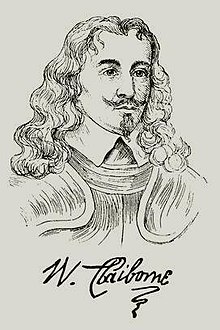William Claiborne | |
|---|---|
 | |
| Secretary of State for the Virginia Colony | |
| In office 1626–1634 | |
| Parliamentary Commissioner and Secretary of the Virginia Colony | |
| In office 1648–1660 | |
| Succeeded by | Richard Kemp |
| Member of the Virginia Governor's Council | |
| In office 1623-1637 | |
| In office 1642–1661 | |
| Treasurer of the Virginia colony | |
| In office 1642–1661 | |
| Treasurer of the Virginia colony | |
| In office 1652–1661 | |
| Personal details | |
| Born | c. 1600 Crayford, Kent, Kingdom of England |
| Died | c. 1677 West Point, Virginia Colony, Kingdom of England |
| Spouse | Elizabeth Butler |
| Children | 4 sons including William Claiborne Jr., 2 daughters |
| Residence | Romancoke |
| Alma mater | Pembroke College, Cambridge University |
| Occupation | Surveyor, colonial government official, trader, planter |
William Claiborne also, spelled Cleyburne (c. 1600 – c. 1677)[1] was an English pioneer, surveyor, and an early settler in the colonies/provinces of Virginia and Maryland and around the Chesapeake Bay. Claiborne became a wealthy merchant and planter, as well as a major political figure in the mid-Atlantic colonies, and the founder of one of the First Families of Virginia. He featured in disputes between the colonists of Virginia and the later settling of Maryland, partly because of his earlier trading post on Kent Island in the mid-way of the Chesapeake Bay, which provoked the first naval military battles in North American waters. Claiborne repeatedly attempted and failed to regain Kent Island from the Maryland Calverts, sometimes by force of arms, after its inclusion in the lands that were granted by a 1632 Royal Charter to the Calvert family. Kent Island had become Maryland territory after the surrounding lands were granted to Sir George Calvert, first Baron and Lord Baltimore (1579–1632) by the reigning King of England, Charles I (1600–1649; reigned from 1625 until his execution in 1649).[2]
Claiborne was an Anglican, a Puritan sympathizer, and deeply resentful of the Calverts' Catholicism. He was one of the signers, along with Virginia Governor John Pott, Samuel Matthews, and Roger Smyth, of a letter to the King's Privy Council, dated 30 November 1629, complaining that Lord Baltimore refused to take the Oath of Allegiance and Supremacy to the Church of England.[3] He sided with Parliament during the English Civil War of 1642–1651 and was appointed to a commission charged with subduing and managing the Province of Virginia and Province of Maryland, both British colonies at the time. He played a role in the submission of Virginia to parliamentary rule in this period. Following the restoration of the English monarchy in 1660, he retired from involvement in the politics of the Virginia colony. He died around 1677 at his plantation, Romancoke, on Virginia's Pamunkey River. According to historian Robert Brenner, "William Claiborne may have been the most consistently influential politician in Virginia throughout the whole of the pre-Restoration period".[4]
- ^ Sources disagree as tp Claiborne's date of birth and which family he descended from in England. Brenner, which is the most recent authoritative historical text, cites 1587 as the date of birth and the Norfolk/Kent Clayborns of England as his ancestors. Other dates and biographical information reflect "Appleton's Cyclopedia of American Biography" 1887–89.
- ^ Warren Billings, "Claiborne, William (1600–1679)" in Dictionary of Virginia Biography vol. 3, p. 255–256, also available at https://encyclopediavirginia.org/entries/claiborne-william-1600-1679/
- ^ Neill, Edward D. (1876). The founders of Maryland as portrayed in manuscripts, provincial records and early documents. Albany, NY: J. Munsell, 1876. p. 45.
- ^ Brenner, p. 120